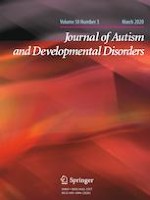06-12-2019 | Original Paper
Examining How Types of Object Distractors Distinctly Compete for Facial Attention in Autism Spectrum Disorder Using Eye Tracking
Gepubliceerd in: Journal of Autism and Developmental Disorders | Uitgave 3/2020
Log in om toegang te krijgenAbstract
Social motivation theory states that individuals with ASD find social stimuli less rewarding (Chevallier et al. in Trends Cognit Sci 16(4):231–239, 2012). An alternative theory suggests that competition from circumscribed interests (CIs) may better account for diminished social attention (Sasson et al. in Autism Res 1(1):31–42, 2008). This study evaluated both theories in children diagnosed with ASD (n = 16) and a group of TD children (n = 20) using eye tracking and demonstrated that distractor type only impacted the proportion of dwell time on faces in the TD group, but not the ASD group. These results provide support for the social motivation theory because gaze duration for faces among children with ASD was diminished regardless of whether the non-social stimuli presented was a CI or control object.
